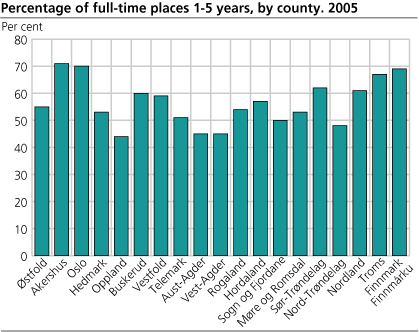Content
Published:
This is an archived release.
10 900 new kindergarten places
By the end of 2005 there were at 231 400 children in kindergartens, 10 900 more than in 2004. 76.2 per cent of all children between 1 and 5 years had a place in a kindergarten.
Oslo and Hordaland had the highest increase in kindergarten places. The increase in kindergarten places in Oslo were 7.6 per cent, while Hordaland experienced an increase 8.2 percent. In comparison, Hedmark had an increase of 50 children or 0.7 per cent.
In 2005 the proportion of children between 1-5 years who had a kindergarten place were 76.2 per cent, an increase of 4 per cent from 2004. Finnmark and Troms had the highest proportion of children in kindergartens, with 81.1 per cent and 79.9 per cent respectively.
Kindergartens in Oslo and Akershus had the highest proportion of full-time places for children aged 1-5 year, with 70.1 and 70,4 per cent respectively. Oppland (44 per cent) had the lowest percentage of full-time places. Children in open kindergartens are not included.
Kindergartens employed 64 500 people in 2005, which is an increase of 4 200 persons since
2004. Two thirds of all employees are assistents and pedagogical leaders, which makes them the two main occupational groups in the sector. 32 700 employees work as assistants and 14 700 employees work as pedagogical leaders. 91 per cent of all employees in kindergartens are women.
Tables:
- Table 1 Kindergartens, children and employees, by county. 2005
- Table 2 Children in kindergartens, by age and county. 2005
- Table 3 Children in kindergartens, by weekly attendance, ownership structure of kindergarten and county. 2005
- Table 4 Children in kindergartens, by hours of attendance per week and different age groups. 2005
- Table 5 Persons employed and man-years worked in kindergartens, by employment position and county. 2005
Contact
-
Elin Såheim Bjørkli
E-mail: elin.saheim.bjorkli@ssb.no
tel.: (+47) 40 81 13 53
-
Elisabeth Haraldsrud
E-mail: elisabeth.haraldsrud@ssb.no
tel.: (+47) 40 81 15 00
-
Per Torstein Tuhus
E-mail: per.torstein.tuhus@ssb.no
tel.: (+47) 40 81 13 49

